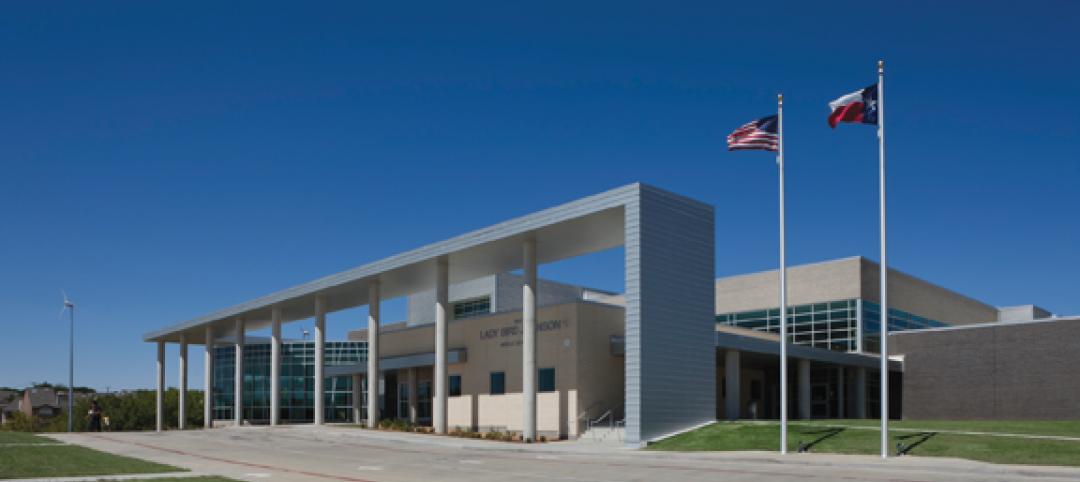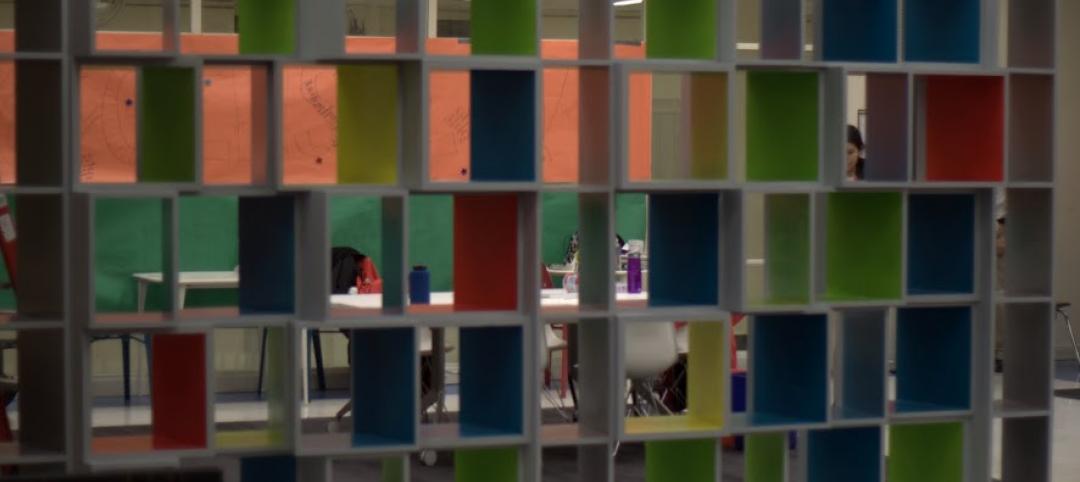Last Tuesday, the Northeast Community Propel Academy, a K-8 school with the capacity for 1,660 students, opened In Philadelphia. The 180,000-sf building was financed and constructed through a public-private partnership between the School District of Philadelphia and Gilbane Development Company, which provided turnkey development for the new school.
Gilbane Building Company acted as the project’s design-builder and hired Stantec as its architect. Gilbane was one of three firms that submitted bid proposals to the school district in the fall of 2017, and received the contract the following January, says Susan Tully, Senior Project Manager and Market Leader for Gilbane’s K-12 Center of Excellence. The school’s design was completed by October 2019, and after some municipal delays construction began in March 2020, “on the day the world stopped” because of the coronavirus pandemic, quipped Tully.
Propel Academy is in a multicultural section of Philadelphia that “is booming,” says Tully, with lots of service sector workers. But the number of school seats hadn’t kept pace with the community’s growth; Tully notes that another school there, built for 600 students, now serves 2,000. The district “knew they need to get a new school built quickly,” she recalls.
The school is on land that previously had served as baseball and softball fields. As part of the P3 agreement, Gilbane Development purchased the land from the school district for $1, and upon completion of construction on August 19, 2021 sold the property and school back to the school district for $79 million.
“Speed to market was a driver” for the P3 arrangement, says Luis Vildostegui, Stantec’s Senior Principal and Education Leader, whom BD+C interviewed with Jennifer Grafton, Stantec’s Project Manager and Senior Associate. Vildostegui notes that Propel Academy’s design reflects the school district’s gravitation toward a more socialized teaching model that focuses on learning with peers.
SCHOOL FEATURES COLLABORATIVE ZONES
Gilbane and Stantec, with Fengate Asset Management, were part of a construction financing consortium that in June broke ground on six K-12 schools in Prince George’s County, Md. This was the first P3 for schools in the nation, and it’s expected to cut in half the time it takes to complete those schools, which are scheduled to open in 2023.
In Philadelphia, the Propel Academy project “is one of the most collaborative I’ve worked on in my career,” says Tully. One of its advantages was Gilbane’s relationship with Stantec, which provided architecture, interior design, and civil engineering services. “We were able to advance the construction before the designs were completed, which fast-tracked the project,” says Grafton. And because Stantec had worked previously with the school district and Gilbane, “we could act as an intermediary” when decisions were made, says Vildostegui.
Stantec’s office in Philadelphia is right across the street from the school district’s, so it set up a big room where all of the project’s stakeholders could meet conveniently. “We were all there, resolving problems from the beginning,” says Vildostegui. Any additions or changes during the design or construction process had to be “cost-neutral solutions,” says Tully. (Nicole Ward, AIA, the school district’s design manager, was its liaison on this project.)
Those discussions included “challenging some basic assumptions,” says Vildostegui, like the building’s placement, which is adjacent to a park that exposures city kids to natural environments they might not see otherwise. During the permitting stage, the building team and school district also hashed out whether a retention basin on the site should be above or below ground (they ultimately chose the latter).
The building team’s early collaboration allowed its members to react quicker when there were materials shortages or delays. “We didn’t need to make compromises,” says Tully.

The Propel Academy was build on land that once served as ball fields, and is located near a tree-lined park.
A ‘SHINING SUCCESS STORY’ FOR P3s
Propel Academy is organized into clusters of classrooms and collaborative zones for small learning groups. There are six classrooms per grade for grades 1-5, and nine classrooms per grade for grades 6-8. The classrooms are positioned around shared media and tech commons within each grade level house, and the number of classrooms can be adjusted as needed.
The school also has science labs, music rooms, and “exploration” spaces, says Grafton. “It’s transformative,” says Vildostegui about the school’s design, that had to meet what Tully calls the school district’s “strict design standards” that are informed by LEED and WELL guidelines.
Tully sees Propel Academy as a “test case” for the school district, and believes P3 financial agreements will be more in vogue for financing school construction to meet clients’ demands for speed. “It’s a shining success story” for the P3 approach, adds Vildostegui. “It’s not for every project, but it’s quicker than a traditional design-bid-build because the issues get moved upfront.”
Related Stories
| Jul 20, 2012
K-12 Schools Report: ‘A lot of pent-up need,’ with optimism for ’13
The Giants 300 Top 25 AEC Firms in the K-12 Schools Sector.
| Jul 2, 2012
Plumosa School of the Arts earns LEED Gold
Education project dedicated to teaching sustainability in the classroom.
| Jun 1, 2012
New BD+C University Course on Insulated Metal Panels available
By completing this course, you earn 1.0 HSW/SD AIA Learning Units.
| May 29, 2012
Reconstruction Awards Entry Information
Download a PDF of the Entry Information at the bottom of this page.
| May 24, 2012
2012 Reconstruction Awards Entry Form
Download a PDF of the Entry Form at the bottom of this page.
| May 24, 2012
Stellar completes St. Mark’s Episcopal Church and Day School renovation and expansion
The project united the school campus and church campus including a 1,200-sf chapel expansion, a new 10,000-sf commons building, 7,400-sf of new covered walkways, and a drop-off pavilion.
| May 21, 2012
Winchester High School receives NuRoof system
Metal Roof Consultants attended a school board meeting and presented a sloped metal retrofit roof as an alternative to tearing off the existing roof and replacing it with another flat roof.
| May 8, 2012
Gensler & J.C. Anderson team for pro bono high school project in Chicago
City Year representatives came to Gensler for their assistance in the transformation of the organization’s offices within Orr Academy High School, which also serve as an academic and social gathering space for students and corps members.
| Mar 5, 2012
Perkins Eastman pegs O’Donnell to lead K-12 practice
O’Donnell will continue the leadership and tradition of creative design established by firm Chairman and CEO Bradford Perkins FAIA, MRAIC, AICP in leading this market sector across the firm’s 13 offices domestically and internationally.















